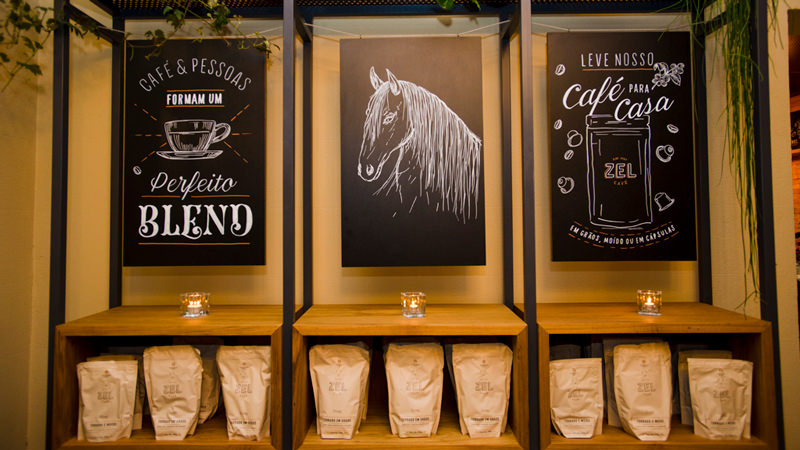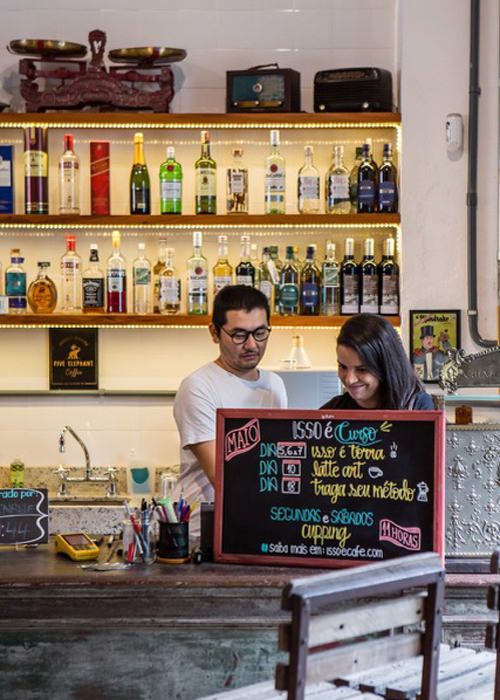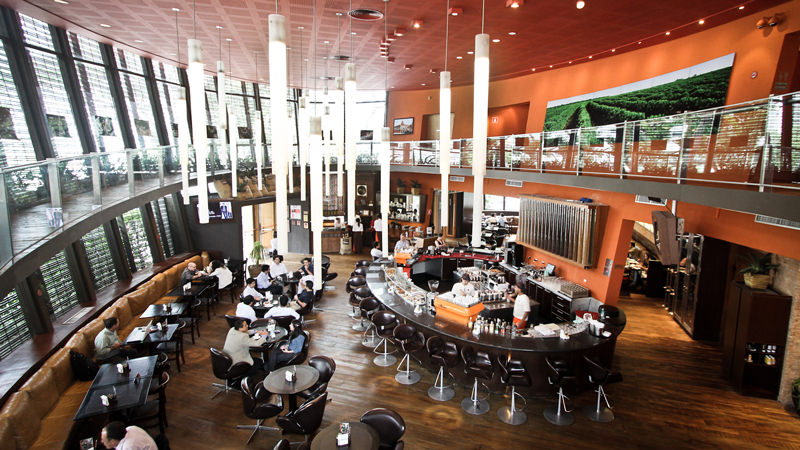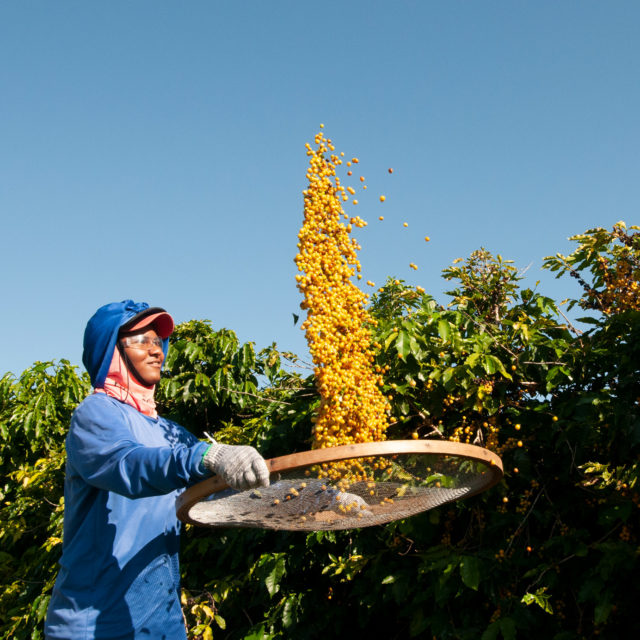It’s the end of the coffee harvest in the Brazilian state of São Paulo, and a warehouse in the capital is buzzing with life. Jute sacks of green coffee beans are piled up, waiting to be put into cold storage. Buyers have come from around the world, and the roasting machine is still warm from the morning roast.
This is Isso é Café, a coffee shop in downtown São Paulo. Brazil’s long-standing concept of “export-grade coffee,” where the best stuff goes to foreigners, is starting to change in this city. Now, specialty coffee shops owned by the growers themselves, like Isso é Café, are beginning to flourish. There are currently more than 10 such places across São Paulo, in all shapes and sizes.
“You have to look hard to find good coffee in São Paulo, but it’s here and it’s unique,” says Isso é Café founder Felipe Croce, a young coffee farmer with a quiet, revolutionary air.

Croce is the fifth generation of a São Paulo coffee farming family that produced conventional “commodity coffee” for nearly 150 years. Then, in 2001, his mother took over the farm on a mission to go organic. It was right at the beginning of the so-called third-wave coffee movement, which Felipe describes as unwritten ethos in which quality, origin, traceability and fair prices all play an essential part.
Brazil is the largest producer of coffee in the world as well as the largest consumer; Brazilians brewed their way through 21 million bags (weighing 132 pounds each) of coffee in 2018. Forward-thinking farmers here started investing in single-origin and single-variety coffees some 20 years ago, but export was their only market until recently. Specialty coffee consumption in Brazil is still a tiny market – just 5 percent of total coffee consumption, according to the Brazilian Specialty Coffee Association – but the potential is huge, experts agree.
“São Paulo is a very serious food city, it’s got a massive population and it’s got spending power,” Croce says. “The origin is also here, with farms close by. But the specialty coffee doesn’t speak for itself. People are creatures of habit. They choose the coffee that reminds them of their grandma’s house rather than the coffee that challenges them, unless you walk them through it.”
This is why spaces like Isso é Café focus as much on educating consumers as they do on growing and serving coffee. Restaurateurs, baristas, and coffee geeks in general are in and out of Isso é Café for cuppings as well as courses that run from latte art to brewing methods.
Croce and his team are involved in every step on the coffee production process. “We’re farmers, we’re baristas, we’re roasters and we’re also tasters. When we choose what variety to plant, we’re always discussing how it might taste. We want to push forward in terms of what’s possible with coffee,” he says.
That experimental spirit is also palpable at Um Coffee, a small chain of coffee shops with a farm 175 miles northeast of São Paulo. Stefano Um, the patriarch, came to São Paulo from Korea when he was eight years old, and fulfilled a lifelong ambition when he bought a coffee farm in 2009. He ripped out the farm’s old and unproductive coffee trees to plant 200,000 new ones, and now grows 23 different varieties. The company exports its micro-lot coffees to countries across Europe as well as Japan, Korea, and the U.S.
At the Um Coffee location in Bom Retiro, a downtown São Paulo neighborhood with a large Korean community, a barista serves me a cup of the farm’s red catauí variety, measuring out the freshly ground coffee into a Kalita Wave filter. She uses a weighing scale that doubles as a stopwatch to measure the time it takes for the water to filter through into the cup.
Precision is important at Um Coffee, from its approach to roasting (on a floor above the coffee shop) to the tests it’s been running this year at the farm, fermenting coffee cherries to develop different flavors.

“We wanted to bring some innovation to the market and try new ways to do coffee,” Stefano’s son Boram tells me. He and his brother were the driving force behind the coffee shops, having seen firsthand what their export clients were doing. They started with the coffee shop in Bom Retiro in 2016, and within two years had two other branches, a clutch of local magazine awards, and plans to open more coffee shops in the coming months.
“Brazil is unique in having so many different producing regions, and it’s easy in São Paulo to access all these different coffees,” Boram says. Um Coffee also serves varieties grown by other producers from different regions, including from Felipe Croce’s family farm, Fazenda Ambiental Fortaleza. Stefano goes to meet the producers and their farms himself. “This transparency is really important to us,” he says, “knowing each grower’s ethics, and knowing how we roasted and serve it.”
As at Isso é Café, changing consumer perceptions is one of the biggest challenges that the Um family faces, and so they too offer a roster of courses as well as free cuppings each weekend. They talk about “converting” customers from standard-grade Brazilian brew, which Felipe Croce calls “bitter sugar water” (sugar being essential to cut through its burnt tang).
Coffee runs deep in the veins of São Paulo. The wealth that came from the state’s coffee boom in the mid 19th and early 20th centuries brought railways and European architecture, not to mention around 4 million immigrants who came to work on the plantations that stretch for 400 miles into the interior of the state.

The city mansions of the São Paulo coffee barons are mostly gone now, bulldozed to make way for high-rises in the latter part of the twentieth century, but a few still stand. One, a 1930s landmark in the upmarket Jardins neighborhood, was restored to become Zel Café in late 2018. The coffee shop, restaurant, and book store is owned by the charismatic José Lauro Megale and run by his daughter Caroline. The coffee – three varieties and a blend – comes from their farm in the Serra da Mantiqueira mountains, just over the state border in Minas Gerais.
José Lauro sold his family’s logistics business in 2015 for more than $250 million and is investing in transforming the cattle and stud farm he inherited from his father. “My father thought I would have sold the farm before he was cold in his grave, but I bought 300 more horses and planted 100,000 coffee trees,” he says. Last year, Zel Cafe produced 200 bags (26,455 pounds) of coffee, and the new trees he planted aren’t even producing yet.
There’s no one model for the family businesses driving this trend. Octávio Café is a pioneer of the farm-to-cup trend in São Paulo, albeit on a larger and more corporate scale. The owners, the Quércia family, of Italian origin, have coffee farms in the Alta Mogiana region of the state with 7 million coffee trees that supply their five coffee shops (two are in an airport). The personal contact with the grower is lost in their coffee shops, but the traceability and quality is.
“Each business has its own origins and approach to coffee,” Croce says. “It’s part of what makes São Paulo so rich and diverse — and all these approaches are starting to make São Paulo’s coffee scene interesting.”
